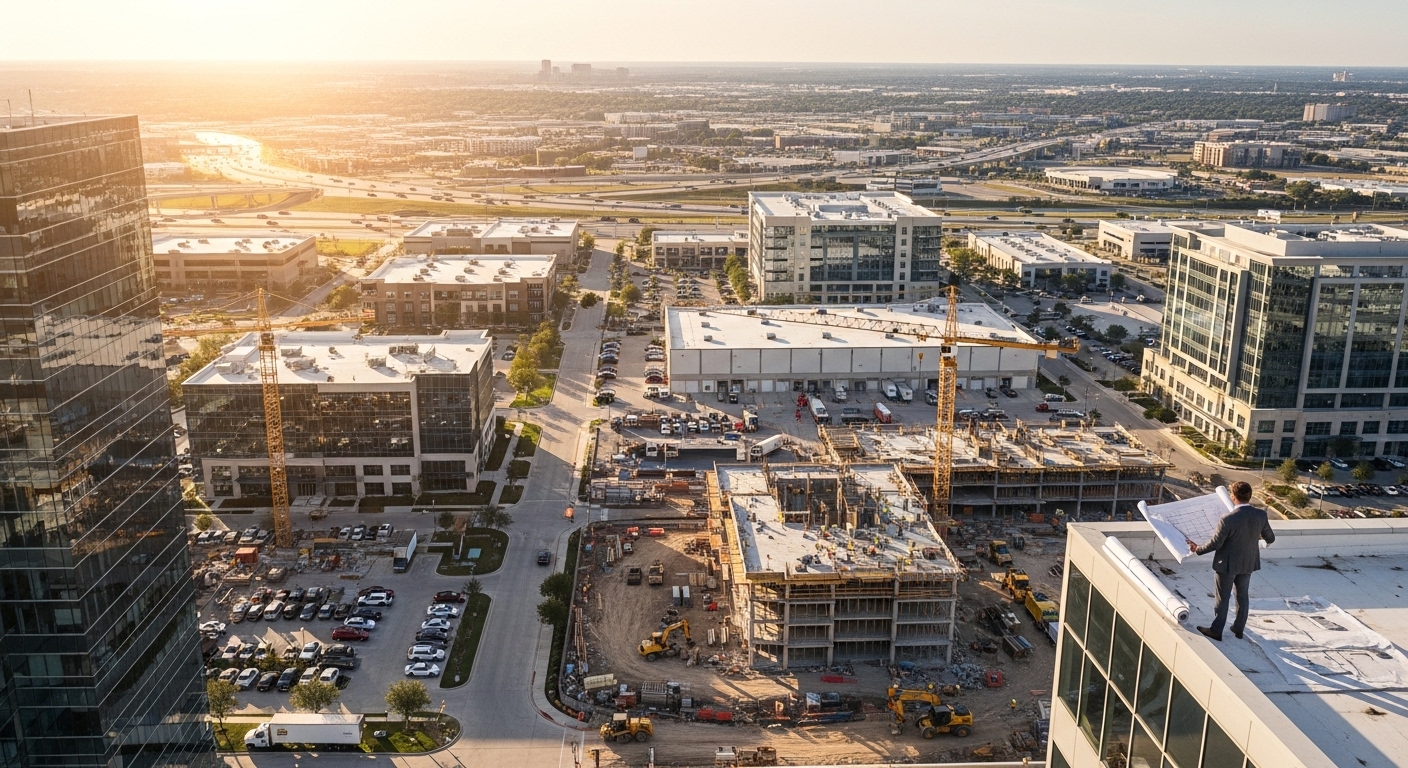Based on the research, I’ll create a comprehensive SEO blog post about Plano, Texas commercial construction trends for commercial building owners and investors.
Strategic Commercial Construction Opportunities in Plano, Texas: Market Insights for Building Owners and Investors
The Dallas-Fort Worth (DFW) metroplex continues to experience unprecedented commercial growth, with Plano, Texas emerging as a critical hub for savvy building owners and investors seeking long-term value. As construction costs stabilize and new development opportunities arise, understanding the current market dynamics has never been more crucial for making informed investment decisions.
The Current State of Plano’s Commercial Construction Market
Plano’s commercial construction landscape reflects broader DFW trends while maintaining distinct advantages for investors. Recent market data reveals construction costs averaging $190 to $340 per square foot across various commercial property types, representing a 3-6% annual increase over 2024 levels. This controlled escalation signals market stability rather than volatility, creating predictable conditions for strategic planning.
The industrial sector has shown particular strength, with Dallas-Fort Worth leading the nation in net absorption. Despite initial post-pandemic adjustments, vacancy rates are stabilizing at 8.5%, while rent growth maintains steady momentum. For building owners and investors, this translates to opportunities for value-add acquisitions and strategic development timing.
Key Market Drivers Shaping Plano’s Commercial Landscape
Population Growth and Economic Expansion: Since 2020, the DFW region has added 450,000 new jobs, with Plano benefiting from its strategic location within this economic powerhouse. The city’s proximity to major corporations and transportation hubs positions it favorably for continued commercial demand.
Corporate Relocations and Expansions: Major companies continue choosing the DFW area for regional headquarters and operations centers, driven by business-friendly policies, competitive operating costs, and skilled workforce availability. This trend directly benefits commercial property owners through increased leasing demand and rental rate stability.
Infrastructure Development: Ongoing infrastructure improvements, including transportation networks and utilities, enhance property values and accessibility. Building owners can leverage these improvements to justify premium rental rates and attract high-quality tenants.
Commercial Property Type Performance in Plano
Understanding sector-specific performance helps investors make targeted decisions based on their risk tolerance and return objectives.
Office Space Market Dynamics
Plano’s office market reflects evolving workplace trends while maintaining competitive advantages. Average asking rents hover around $32.15 per square foot, with high-quality suburban office spaces in mixed-use developments showing particular strength. The market offers opportunities for building owners who can provide modern amenities and flexible configurations that meet current tenant demands.
Investment Considerations for Office Properties:
- Focus on Class A properties with modern infrastructure
- Prioritize locations near transportation hubs and amenities
- Consider buildings with potential for mixed-use conversion
- Evaluate properties with existing long-term, credit-worthy tenants
Industrial and Warehouse Opportunities
The industrial sector presents compelling opportunities for value-oriented investors. With annual rent growth of 4.7% and average asking rents at $9.90 per square foot, this segment offers steady returns with lower volatility than other property types.
Strategic Advantages for Industrial Investors:
- Strong demand for last-mile distribution facilities
- Proximity to DFW Airport enhances logistics appeal
- E-commerce growth drives continued demand
- Lower per-square-foot construction costs create development opportunities
Retail Property Resilience
Plano’s retail sector demonstrates remarkable resilience, with the DFW market leading major metropolitan areas in net absorption. Average retail rents reach $24.45 per square foot, with consistent 4% year-over-year growth maintained for eleven consecutive quarters.
Retail Investment Highlights:
- Focus on necessity-based retail and service providers
- Mixed-use developments show strongest performance
- Demographics support premium retail concepts
- Adaptive reuse potential for underperforming properties
Construction Cost Analysis for Strategic Planning
Understanding construction costs enables building owners to evaluate development opportunities and assess property improvement potential accurately.
Current Construction Cost Breakdown by Property Type
Office/Corporate Buildings: $210-$330 per square foot
- Driven by tenant improvement allowances and technology infrastructure
- Energy efficiency requirements add 2-3% to total costs
- Design-build delivery methods offer cost control advantages
Industrial/Warehouse Facilities: $160-$250 per square foot
- Most cost-effective construction option
- Steel price stabilization supports budget predictability
- Tilt-wall construction methods optimize efficiency
Retail/Restaurant Properties: $230-$370 per square foot
- Finish quality and HVAC requirements drive premium costs
- Kitchen and specialized equipment installations add complexity
- Brand compliance standards impact construction specifications
Key Cost Variables Affecting Project Budgets
Labor and Subcontractor Availability: Skilled trades commanding 4-5% annual wage growth through 2026, making early contractor engagement critical for cost control.
Material and Supply Chain Stability: Structural steel and concrete prices have stabilized, though lead times remain extended. Strategic material procurement can significantly impact project timelines and costs.
Regulatory Compliance: New energy efficiency standards and fire protection codes add 2-3% to construction costs but enhance long-term property values and marketability.
Emerging Opportunities in Adaptive Reuse and Mixed-Use Development
The Texas Legislature’s consideration of zoning reform presents unique opportunities for forward-thinking investors. Proposed legislation would ease restrictions on converting commercial properties like office buildings and shopping centers into residential or mixed-use developments.
Strategic Implications for Property Owners
Office-to-Residential Conversions: With office vacancy rates remaining elevated, well-positioned buildings offer conversion potential that could unlock significant value. Key factors include:
- Adequate floor plate configurations for residential layouts
- Parking ratios suitable for residential use
- Proximity to amenities and transportation
- Structural feasibility for plumbing and HVAC modifications
Mixed-Use Development Potential: Properties suitable for mixed-use conversion can capitalize on Plano’s growing population and changing lifestyle preferences. These developments typically command premium values due to their diversified income streams and reduced vacancy risk.
Technology Integration and Smart Building Features
Modern commercial properties increasingly require technology integration to remain competitive. Building owners who invest in smart building systems, high-speed internet infrastructure, and energy management systems position their properties for premium rental rates and longer-term tenant retention.
Value-Add Technology Investments:
- Building automation systems for energy efficiency
- Enhanced telecommunications infrastructure
- Electric vehicle charging capabilities
- Security and access control upgrades
- Flexible HVAC systems for space reconfiguration
Financial Strategies and Market Timing
Current market conditions present both challenges and opportunities for building owners and investors. Understanding financing options and market timing can significantly impact investment returns.
Financing Considerations
Construction Financing: Interest rates have stabilized, though they remain elevated compared to recent historical levels. Developers and investors should evaluate fixed-rate options for longer-term projects and consider phased development approaches to manage risk.
Value-Add Financing: Properties requiring significant improvements may benefit from specialized financing products that account for post-improvement valuations. These strategies work particularly well in Plano’s appreciating market.
Refinancing Opportunities: Existing property owners should evaluate refinancing options as market conditions evolve, particularly for properties with improved occupancy or rental rates.
Risk Mitigation Strategies for Commercial Investors
Insurance Cost Management
Commercial property insurance costs have increased significantly, with some sectors seeing costs double. Industrial properties show the smallest increases (from 5% to 7% of operating costs), while multifamily properties experienced the largest jumps (from 7% to 14.3%). Building owners should:
- Evaluate insurance options annually
- Consider risk mitigation improvements that reduce premiums
- Factor insurance costs into acquisition and development budgets
- Explore self-insurance options for larger portfolios
Market Diversification
Investors should consider diversifying across property types and geographic areas within the DFW market to reduce concentration risk. Plano’s location provides access to multiple submarkets while maintaining the benefits of a single management focus area.
Partnering with Expert Construction Management
The complexity of today’s commercial construction environment demands experienced partners who understand local market conditions, regulatory requirements, and cost management strategies. Alder Designs brings over 70 years of combined construction expertise to commercial projects throughout the Dallas-Fort Worth area, including Plano.
Why Professional Construction Management Matters:
- Proven project delivery systems minimize delays and cost overruns
- Established relationships with qualified subcontractors ensure quality
- Regulatory knowledge prevents compliance issues
- Value engineering expertise optimizes project budgets
Services Tailored for Commercial Property Owners:
- Property condition assessments to identify improvement opportunities
- Capital needs analysis for long-term planning
- Construction management for renovations and improvements
- Third-party inspections and contractor audits
Looking Ahead: Strategic Planning for 2025 and Beyond
Plano’s commercial real estate market offers compelling opportunities for investors who understand the evolving landscape. Key trends to monitor include:
Continued Population Growth: The DFW metroplex’s population expansion supports ongoing commercial demand across all property types.
Corporate Expansion: Business-friendly policies and infrastructure development continue attracting corporate relocations and expansions.
Development Pipeline: Planned infrastructure improvements and master-planned communities create new commercial opportunities.
Market Maturation: As the market matures, opportunities shift toward value-add investments and strategic repositioning.
Taking Action in Today’s Market
For building owners and investors evaluating opportunities in Plano’s commercial market, the current environment offers several advantages:
- Market Transparency: Comprehensive data availability enables informed decision-making
- Construction Cost Predictability: Stabilizing costs support accurate project budgeting
- Professional Expertise: Experienced construction partners help navigate complex projects
- Financing Options: Multiple financing alternatives accommodate various investment strategies
The key to success lies in thorough market analysis, careful project planning, and partnering with experienced professionals who understand the local market dynamics. By focusing on fundamental market drivers and maintaining a long-term perspective, commercial property investors can capitalize on Plano’s continued growth and development.
Whether considering new development, major renovations, or strategic acquisitions, building owners who act decisively with proper professional support position themselves to benefit from Plano’s robust commercial real estate market for years to come.


0 Comments